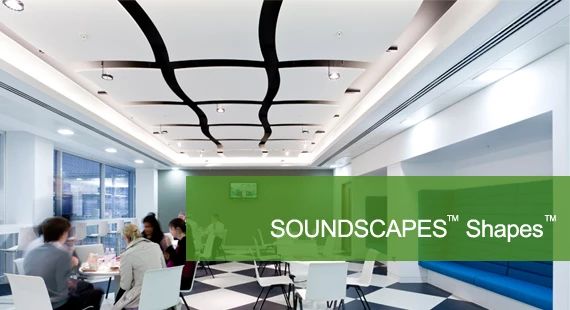
Are you living in a room that is full of noise and echos? Large areas, especially, tend to have a lot of noise bouncing off the walls. However, this can be true for large commercial buildings as well as churches. And, of course, sound studios need acoustic paneling to ensure that the acoustics are good for recording voices.
Ceiling tiles work perfectly in helping aid with the room’s acoustics. They typically attach directly to the ceiling or they are used in a drop ceiling where they are suspended below the actual ceiling. These are very effective in dampening the sounds around them. These tiles come in a wide variety of styles and designs to choose from. The tiles are easy to use and make the area that they are used in much more comfortable for the inhabitants. They are used to block, diffuse or absorb the sound. Some options are very beautiful while others are just there to literally stop the sound from traveling. There are even lower sound ceilings that are installed in large open areas such as hospitals and malls to help stop the soundwaves from bouncing and sounding super echoey.
Finding good noise reduction ceiling tiles
If you have a very loud room, then you need to look at the noise reduction coefficient (NRC) of the ceiling tiles that you are looking to work with. Often times the ceiling tiles are not going to stop the sound on their own. They are just one of the many factors that you can try to get the best sound. The more soft materials you have in the room, the better as well. Sound loves to bounce off hard surfaces. If you have a hard floor with hard walls and ceiling the room is going to be very echoey. However, as you add furniture, pillows, soft wall decor you will see this get better. The ceiling tiles with a good NRC will help as well. Thankfully, we supply acoustic ceiling panels in South Australia
Some things to consider
People who are looking for getting better soundproofing are going to be looking for ceiling tiles that are called acoustical ceiling tiles. However, remember, this is also a marketing tool for ceiling tiles as well. Some ceiling tiles are naturally softer than what you might find in drywall, so they will offer a better noise reduction. However, there are tiles that are actually made for this particular application. Those are the tiles you are looking for. The average drop ceiling materials that are used in basic ceiling tiles are oftentimes better than drywall ceilings for a number of reasons. Yes, it is a softer material but drop ceilings make the room smaller. Smaller rooms have less of a tendency to be less loud.
When drop ceiling panels were first brought to market people didn’t realize that it would have so much effect on the acoustics of the room. Once this was discovered all the drop ceiling tiles were marketed as “acoustical ceiling tile” but really it did not change at all and was a marketing ploy. “New and Improved” started to come out everywhere, but really it was what the ceiling tiles were already made of, just a new discovery for those that used them.
Sound Absorbing Ceilings

A conventional room has at a min. 6 structures that form it. These are the floor, four walls, and a ceiling. Sound is not like heat. Heat rises over time, but should travels in all directions at the same level. So, it doesn’t hit the ceiling in the manner that heat does. But, most people don’t think this way. We think that putting damping in the ceiling will be a cure-all and everything will be perfect. However, this is because of marketing and has nothing to do with what actually happens. Wall hangings and curtains have a larger effect on sound but they are rarely purchased for this purpose. This again is due to marketing. And, nobody shops for an acoustical chair, however, the furnishings have a lot of doing to the acoustical nature of the room. What you find in the room will affect the rooms acoustic nature.
If you are looking for acoustic help with the use of your ceiling tiles, you are in luck. Ceiling tiles will help noise reduction, but we just wanted to ensure that you have realistic expectations. In most cases, most people cannot tell the difference between the different tiles. As that is not the only place that the sound is traveling. So, choose wisely when you are looking at the tiles for your ceiling.
Sound Ratings
There are different sound ratings that you need to look for when looking at ceiling tiles. These are the noise reduction coefficient (NRC), the Sound Transmission Class (STC), and the Ceiling Attenuation Class (CAC). Each of these measures sound in a different way.
NRC
NRC is a general rating. This is to tell you how much sound this particular material, in our case a ceiling tile, will absorb. This is very common to use for walls and partitions. This rating scale is 1 behind 100% absorbed and 0 being nothing absorbed.
STC
This rating is measuring the ability of a material to block sound. This too is used in all kinds of different building materials. The rating scale may be from 1 to 100, the higher the number the better it is at blocking.
CAC
This rates the passage of sound. Sometimes the sound will travel up walls and through vents. This phenomenon is known as CAC. This rating is probably the most misunderstood rating and really doesn’t apply much to ceiling tiles.
When looking at the ratings, there is no hard-fast rule to go by. But, knowing them will give you a better chance of understanding what you are looking for and understanding how to find the acoustic tile of your dreams.
Acoustic panelling for ceilings was discussed here. However, we also have spoken about Do soundproof ceilings work? and how can I soundproof a large room? You should take a minute and check those out as well for more information about soundproofing with ceiling tile.



